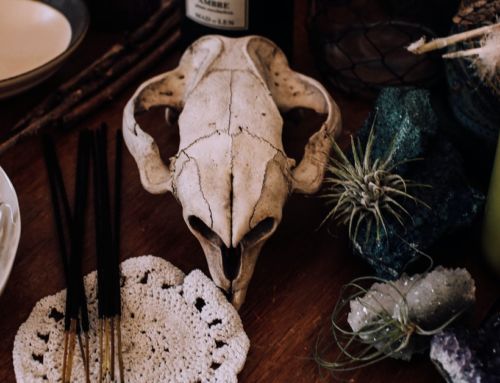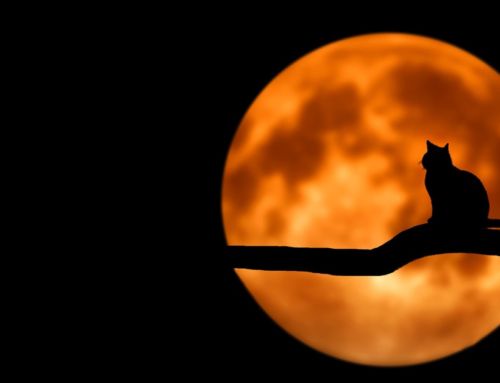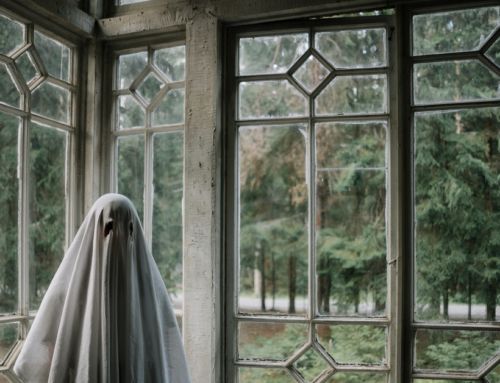Five Winter Monsters That Will Give You the Chills
It’s January, the holidays are over, and we are left with icy, snowy weather and no lights to brighten the dark winter nights. Despite short days and frustrating commutes, for most modern people life goes on in the winter just like it does at any other time of the year. We have warm houses and plenty of food, even when we travel we do so in the comfort of a heated car. It can be easy to forget that for our ancestors winter was a harsh time that often brought starvation and death by freezing. For those who lived a migratory lifestyle or had to travel for trade or to hunt, a sudden winter storm could mean being trapped in the wilderness with no food and no way to get home. It’s no surprise that people all over the world have passed down stories about the perils of ice and snow. Here are five monsters you definitely don’t want to run into on a cold winter night:

The Wendigo
This legend comes to us from the Algonquian speaking tribes of the northern plains states and Canada. The Wendigo story dates back to pre-colonial times and has persisted into the modern day. There are many variations on this tale, but they all agree that a Wendigo is a monster associated with greed, starvation, cannibalism and extreme winter conditions. Most stories about the Wendigo start with someone traveling alone or in a small group during the winter. Depending on the story, the Wendigo is either a creature who attacks a traveler or a spirit that possesses a traveler and causes him to attack other people.
The Wendigo is usually described as a giant-sized creature with pale flesh clinging to its bony, starving frame, it often has sunken eyes and missing lips that reveal long fangs and an unusually long tongue. Sometimes it is described as having antlers or horns coming out of its head and matted fur on its body. When it eats a person it grows proportionally to the person it has eaten, this prevents it from being able to gain weight or feel satisfied; its hunger is insatiable. If a person is possessed by the spirit of a Wendigo they still look human, but they become irrational and violent, often attacking people around them and eating them.
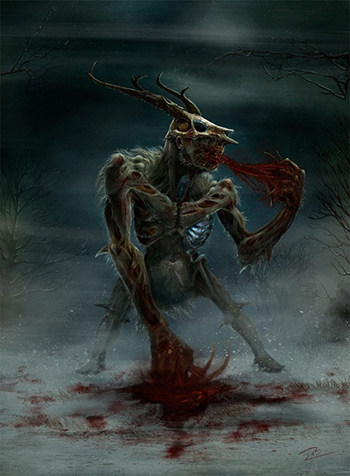
Most Wendigo legends emphasize the importance of community and of sharing resources when times are scarce. A person who is greedy and refuses to share food with starving people will become a Wendigo or become prey for a Wendigo, depending on the story. The Wendigo possesses supernatural speed and hunting abilities. It can not only devour the body of its target, but it can also strike at their mind. Stories tell of the Wendigo causing its victims to go insane and run out into the woods away from the protection of their community. According to some legends, the older a Wendigo gets, the more powerful it grows, eventually gaining the ability to summon storms and bring early darkness.
Even more disturbing are the real-life events that have been linked to the Wendigo legend. There are several documented cases of Native peoples in this area succumbing to “Wendigo Psychosis”. This condition only occurs when a person is isolated during winter storms and does not have enough food to eat. The victim becomes nauseous and ill, people around them start to appear edible, and they become extremely anxious that they will become a cannibal. Some people with this condition have become violent and cannibalistic, later stating that they were possessed by a Wendigo. Traditionally, people in the earlier stages of this illness would be treated by a Medicine Man with special ceremonies designed to keep them from turning into a Wendigo. If a person actually killed and ate someone, they were considered to be a Wendigo and were killed for the safety of the tribe. Many Algonquin tribes held ceremonial dances during times of scarcity to remind people of the dangers of the Wendigo and reinforce altruistic behaviors that would keep the creature at bay.

Yuki-Onna
No winter legend captures the perilous beauty of winter like Yuki-Onna, the “Snow Woman” of Japan. She is the spirit of a young woman who froze to death. Yuki-Onna is usually described as being beautiful, with long black hair, pale skin, and blue lips. She seeks to regain the warmth she lost by feeding on the life force of others. Sometimes she will cause people to lose their way while traveling and freeze to death, other times she will come into your house as an icy wind and freeze you while you sleep. She often carries a child known as the Yukinko, when a passerby tries to take or hug the child they will be covered in snow and die.
There are other stories of Yuki-Onna that paint her as less ruthless. There is one tale of her marrying a human man, when he wants her to take a warm bath, she is reluctant but then gives in and melts in the bathtub, leaving only floating icicles. She is said to show mercy on people who she finds particularly good looking or whom she judges to be good parents or good spouses.
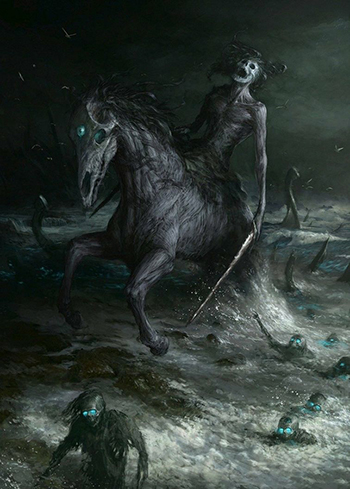
Nuckelavee
The Nuckelavee is a terrifying winter sea monster that lives in the ocean near the Orkney Islands of Scotland. It is thought to be a composite folklore of both Norse and Celtic origin. The Nuckelavee is described as a horse with the torso of a man attached to it’s back as if it were a rider. The horse part of the creature has fins on its feet, and the man part has grotesquely long arms that dangle down nearly to the ground. The horses head has a wide gaping mouth and a single red eyeball in the center of its forehead. The creature does not have skin and is covered in yellow veins pulsating with black blood.
The Nuckelavee is bound to the ocean during the summer months by the Mither o’ The Sea, a benevolent Orcadian sea spirit, but during the winter it can come on land and wreak havoc. The toxic vapor of its breath can sicken livestock and young people and wither crops. It is blamed for periods of low rainfall and for plagues and famines. The only way to escape the Nuckelavee is to cross flowing fresh water, such as a river. Traditionally the name of the Nuckelavee was hardly ever mentioned aloud, as it was thought to bring bad luck.
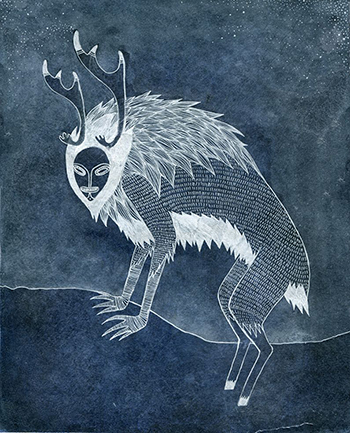
Ijiraq
An Ijiraq is an Inuit shapeshifter that lures travelers astray and kidnaps children. According to traditional Inuit belief, if a person walks too far to the north, they will cross over from the land of the living into the spirit world. An Ijiraq is believed to be one of these unfortunate people who has become trapped between the world of the living and the world of the dead.
An Ijiraqs natural form is that of a human with sideways eyes and a sideways mouth. It can take any shape it wants and usually disguises itself as an animal, often a caribou. Regardless of what form it takes an Ijiraq always has red eyes. Even so, it is not always easy to tell if you have encountered an Ijiraq. To really see an Ijiraq, you have to look at them out of the corner of your eye. They can appear shadowy and are often surrounded by disorienting mirages. Everyone who has encountered an Ijiraq has reported memory loss soon afterward. The Inuit encourage surviving victims of the Ijiraq to tell as many people as possible about their experience before the memory fades.

An Ijiraq can cause even the most experienced trackers to become confused and lose their way. There are stories about victims of Ijiraq who have walked in circles very close to their destination without ever finding it. Ijiraq also kidnap children and then abandon them in the woods. In some stories a kidnapped child can convince the Ijiraq to free them and then use cairns of balancing rocks, called inukshuk, to lead them home. In other stories, Ijiraq cannot pass by an inukshuk and will release a child if it comes to one near the child’s home.
Despite these unsettling stories, some Inuit elders have suggested that the Ijiraq are merely acting to protect their territory and keep others from becoming trapped between worlds.
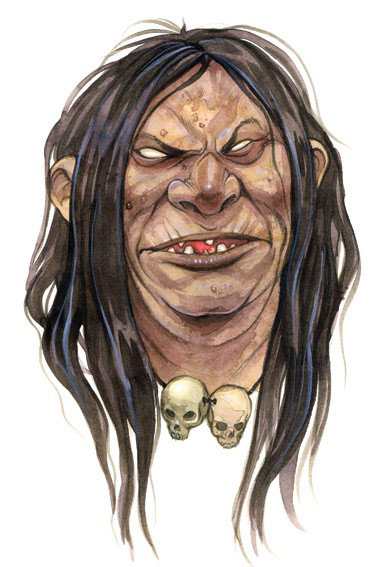
Ikuutayuq
Another legend of the Inuit, Ikuutayuq is even more horrifying than the Ijiraq. Her name means “The One Who Drills”. Ikuutayuq and her nameless brother capture people and take them to a ritual circle of ice pillars. The brother’s job is to hold Ikuutayuq’s victims down while she uses the sharp pillars of ice to drill holes in them. The bodies are then left buried under the ice pillars. Thankfully, if you visit the Arctic today, you don’t have to worry about being captured by Ikuutayuq. According to Inuit legend, an ancient hero killed Ikuutayuq. After her death her brother fled, never to be heard from again. Even though she is supposed to be dead and gone, we still think she’d make a great villain in a horror movie.




